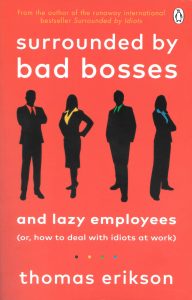The one sentence summary
Being a good boss and coping with people at work is all about understanding their psychological type.
Can’t be bothered to read it? Too much screen time lately? Listen to the 5-minute podcast in 2 parts.
WHAT THE BOOK SAYS 
- This book is subtitled (surrounded by) lazy employees (or, how to deal with idiots at work). Once again the author draws on the four-colour behavioural model made famous in Surrounded By Idiots and Surrounded By Psychopaths. The differences between types can be summarized by an anecdote when each type walks into an elevator:
- Blue person: calculates the weight of everyone in the lift in relation to the maximum permitted load
- Red person: goes straight in and presses the button repeatedly
- Green person: Uses the ‘open the door’ button so everyone can get in
- Yellow person: sees the journey as a great opportunity to chat
- The book includes a range of tactics to understand and outsmart vexatious bosses and flaky employees such as a controlling micro-manager or a ‘nice’ boss that is actually a professional backstabber.
- Good bosses need to distinguish clearly between two roles:
- Leader: achieves results through others
- Specialist: achieves results themselves
- You can immediately see that any boss who does it all themselves will be ineffective. Boss is what you are. Leader is what you do. The boss is the person you must follow – the leader is the person you want to follow.
- Task-oriented people are more interested in concrete tasks than in relationships, and vice versa. Effective leadership is partly task-oriented and partly commitment-oriented. You need people with high will and high skill (competence and commitment).
- Behaviours are one thing – personality is something else.
- A good boss says: “I need your help.”
- A powerful question to staff who are always asking for permission is: “If you hadn’t been able to ask me, what would you have done?”
- A good boss finds the right balance between instruction and support, including education, challenging, delegating, and being present.
WHAT’S GOOD ABOUT IT
- Only 10% of all employees can be classified as top performers, 70% are average, and 20% are under achievers.
- When it comes to information, Reds want brief facts, so get to the point; Yellows want to be convinced emotionally, so summarize; Greens are thorough and want confidence building, so explain; Blues want all the facts and evidence, so go into detail.
- Two models for implementing change:
- Follow up. 2. Follow up. 3. Follow up.
- Follow up. 2. Assess. 3. Persevere.
- Douglas McGregor, in his book The Human Side of Enterprise, described two sets of assumptions about what motivates people:
- Theory X: people have an aversion to work so they need strict supervision, rewards and penalties.
- Theory Y: people want job satisfaction and can be encouraged to approach tasks without direct supervision.
- People quit to leave their boss, not their job.
WHAT YOU HAVE TO WATCH
- There is much to admire here, but a fair amount of repetition if you have read either of the other two books.
